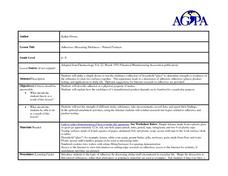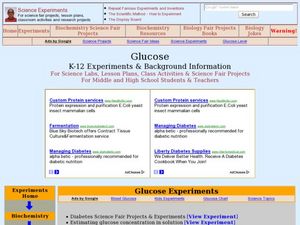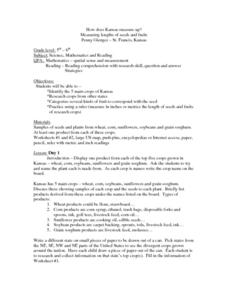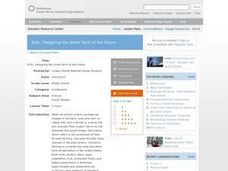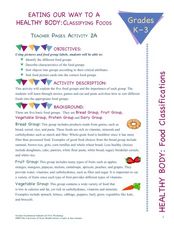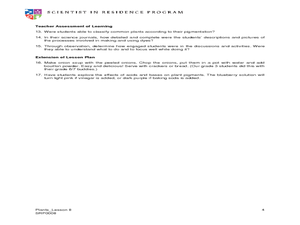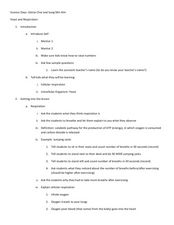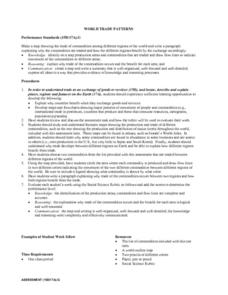Curated OER
Oklahoma Wheat on the World Market
Sixth graders explore profit and loss in the wheat trading market. In this sixth grade mathematics lesson plan/social studies lesson plan, 6th graders play a “Wheat Market Trading Game” in order to investigate the concept of supply and...
Curated OER
Filling Up
In this filling up worksheet, students calculate the E85 per gasoline-gallon equivalent price to the E85 price per gallon to complete a chart of "alternative fuel". They use the data along with the price per gallon of gasoline to plot...
Curated OER
Adhesives: Measuring Stickiness
Students test the stickiness of natural substances. In this adhesion as a property of matter lesson plan, students build a tool to test the adhesion of natural "glues" such as honey, peanut butter, flour and water paste, and jelly. ...
Curated OER
Glucose
Students conduct various experiments on glucose. In this biology lesson, students differentiate the process of diffusion and osmosis. They test different foods for the presence of glucose and starch.
Curated OER
How Does Kansas Measure Up?
Students identify the five main crops of Kansas and crops that are produced in other states. The categorize the types of fruits and seeds of each plant and measure each to compare the length of each.
Curated OER
Leveled Problem Solving: Choosing and Analyzing Data Displays
In this using a bar graph to solve word problems worksheet, students choose and analyze data to problem solve. Students solve six problems.
Curated OER
The Quicker the Better? Food Processing
Sixth graders evaluate the nutrition of various foods. In this healthy eating instructional activity, 6th graders discuss the processing of many common foods and what this means. Students identify and research unfamiliar ingredients in...
Curated OER
Soil, Designing the Small Farm of the Future
Students examine the history of farming. In this environmental farming lesson, students explore the web and complete a variety of activities in order to understand the necessity of local, sustainable, and small farms for the future....
Curated OER
Making Paper
Students explore paper making. In this cross curriculum multicultural ecology and art lesson, students follow written and oral instructions to make paper using common household items. Students predict the amount of paper use in their...
Curated OER
Mind Over Matter: How Does the Brain Work
Students research previous attempts by scientists to discover the ways in which the brain works, design and conduct an experiment to illustrate current research and present their findings to the class.
Curated OER
The Ancient Maya
Young scholars explore the culture of the Mayans through a variety of activities. In this lesson about Maya, students analyze pictures in books and on websites, produce scale models of Maya architecture, and create Maya mosaics. Young...
Curated OER
Calories and Nutrition
In this calories worksheet, students use a chart comparing the calories found in different food items to complete 3 short answer questions.
Curated OER
Planet Zorcon
Students relate the geography and economics of Utah. In this geography instructional activity, students log their use of resources both natural and synthetic. Students participate in an experiment to understand how the Earth will be in...
Curated OER
Pumpkins . . . Not Just Part of Halloween
Students study the pumpkin. In this pumpkin lesson, students participate in different activities that explain the history of pumpkins and how pumpkins develop and grow, read "The Great Pumpkin Story" and answer comprehensive questions...
Curated OER
Eating Our Way to a Healthy Body: Classifying Foods
Learners examine the major food groups. For this classifying foods lesson, students discover the 5 food groups as they read books and play games. Learners then sort foods into the appropriate food groups
Curated OER
Serfs and Lords
Young scholars determine what the roles of serfs and lords were in feudal society. For this feudalism lesson, students examine what life was like for the different classes by looking at farm and manor life. They listen to Till Year's...
Curated OER
The Amazing Tomato
Learners gain an understanding of where our food comes from. In this plant life lesson, students review what plants need for growth and how long it takes them to grow. Learners research which plants it takes to make salsa. Students then...
Curated OER
Using Plant Pigments as Natural Dyes
Students create friendship bracelets and quilt squares. In this plant instructional activity student dye their own string and cotton material with plant pigments. Students use the naturally dyed materials to create the friendship...
Curated OER
Ag in My Community; Agriculture
Students build knowledge about agriculture as it relates to their communities' commodities. In this agriculture lesson plan, students brainstorm about conditions in their community with regards to growing different types of crops....
Curated OER
Yeast and Respiration
Students explore oxygen properties by conducting a cell experiment in class. In this respiration lesson, students discuss the process of breathing and how oxygen is inhaled before carbon dioxide is exhaled. Students utilize yeast, water,...
Curated OER
Economics: World Trade Patterns
Students examine world trade patterns and discover the role of commodities in trade. While explaining the benefits of trade, they create maps and flowcharts depicting the patterns of goods and people movement. Also, students write...
Curated OER
TAPAS
Third graders, with a partner, choose English and Spanish recipes and make them at him, videotaping themselves making tapas and explain what they're doing in Spanish.
Curated OER
Benefits of Biotechnology
Various aspects about the impact of biotechnology in our everyday lives, and many examples of its application are given in these slides. Designed with multiple fonts, the style should be appealing to youth.
Curated OER
Lost in Uruguay
This quiz on the culture and geography of Uruguay may serve best as a sponge activity for those who have finished an assignment. Questions are multiple-choice, and each correct answer is worth 15 points. Quiz-takers must earn 1000 points...




